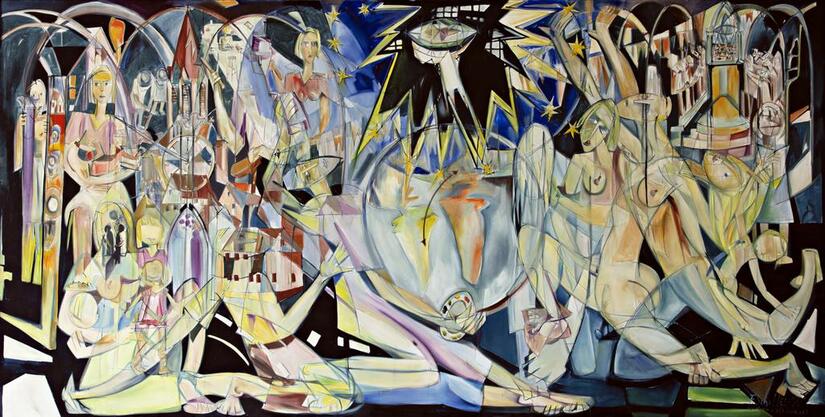Flavio Scholles: Suche nach der Wurzel, 1996 (Search for the Root)

Oil on canvas, 400 x 200 cm
No artist is happy if, when looking at his work, one thinks, at first, of another artist. And yet, at first glance Flavio Scholles' painting calls to mind one of the most famous works in the world: "Guernica" by Pablo Picasso (although Scholles has no problem with this, and, by his own admission, his artistic orientation is actually based on Picasso). "Suche nach der Wurzel” (Search for the Root) is a commissioned work of the Europäische Akademie Otzenhausen. It was ordered after Flavio Scholles (*1950 in São José do Herval, Brazil) had shown the exhibition "Tell me about your homeland" here in 1996.
What kind of roots is his painting about? First, the roots of the European Union – a vision of peace. A project that emerged from the horrors of the Second World War, which Scholles depicts so vividly that it gets under the visitor's skin. Violence, crime, the second catastrophe of the 20th century ... from all that rises a circle of stars in blue and yellow at the upper edge of the painting (after the motif of the European flag). This idea of the peaceful unification of the peoples of Europe was also the basic idea behind the creation of the Europäische Akademie Otzenhausen in 1954, less than ten years after the war, as an initially Franco-German educational and meeting center for young people.
With Europe, Flavio Scholles is also searching for his own roots. Four generations ago, Scholles' family, like so many others, emigrated from the Hunsrück region to begin a new life in Brazil. He spent his childhood in poor circumstances as the youngest of eleven children. He lost his father when he was three years old. At the age of nine, he received a scholarship. Thanks to this support, the destitute boy became a world-famous painter whose style ranges from Expressionism to Cubism and Constructivism. With his works he describes the culture and history of European emigrants, including those from the Saarland, his "second home". For this purpose, he uses motifs from his "first homeland" Brazil, where he now lives and works in his birthplace São José do Herval.